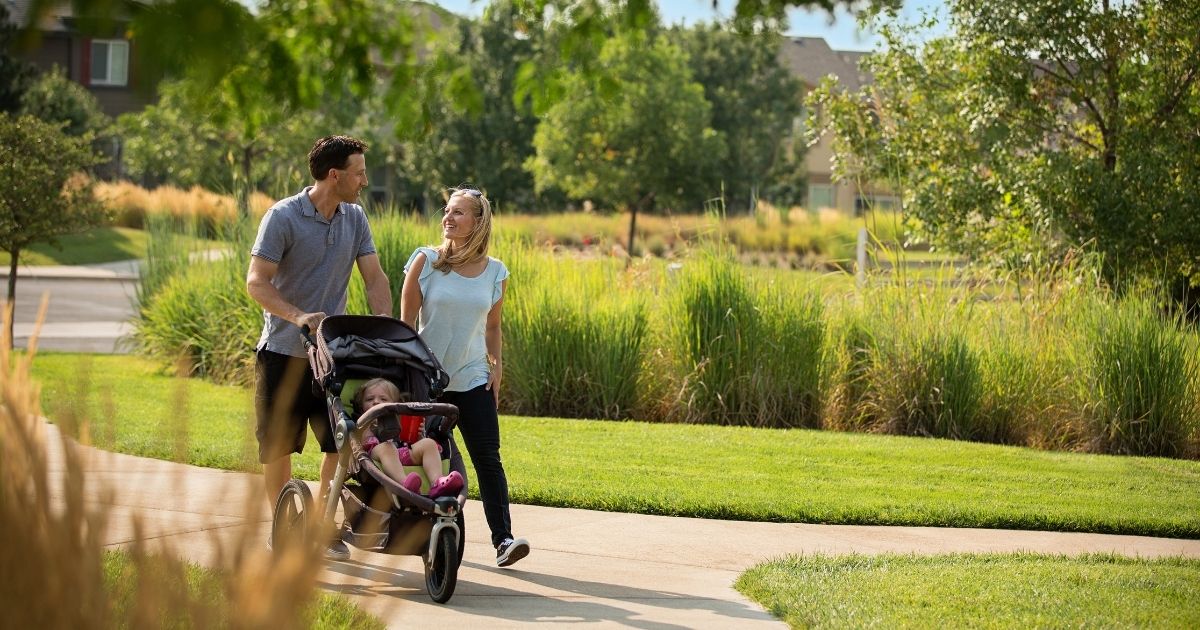Be Part of a True Community with New Homes in Colorado From Oakwood Homes
During the past two decades, developers have focused on building new homes in suburban locations a considerable distance from the heart of the nearest big city. That worked at the time. People were content to live at a slower pace, a step removed from the hubbub of urban crowds, traffic, and crime. Life moved at a comfortable pace as parents raised their children in relative safety, sending them off to college to discover the larger world.
A Growing Movement
This tendency is now swinging in the opposite direction as Millennials and Gen Zs become the prime buyers of new homes. Having been raised in the age of the internet, these young adults are more trend-savvy. They know what goes on in the rest of the world because it comes to them on their cell phones, tablets, and laptops. These younger consumers crave socialization and interaction with peers.
This is a major driver for the walkable neighborhoods springing up in cities throughout the country. A one-mile trek through a walkable community takes these active social-seekers past numerous retail outlets where they can shop, dine, or relax with friends; whereas, the same walk through a suburban neighborhood may not take them anywhere near retail or other businesses.
New home builders, such as Oakwood Homes in Colorado, are starting to realize that walkable neighborhoods — those with designated safe areas for walking or biking to work and nearby amenities such as restaurants, shopping, and entertainment — are here to stay. Designing new home communities with this in mind satisfies a growing need for today’s modern home buyers looking for new homes in Colorado and across the country.
The Benefits of Walkable Neighborhoods
Walkable neighborhoods provide many benefits for the residents and the city, in general. Here are just a few of the more significant advantages of living in a walkable community.
Better health.
People who live in walkable neighborhoods often enjoy better health than their suburban counterparts. Studies show that the average resident of a walkable community may be at less risk for obesity, heart disease, and diabetes. This is due to the health benefits gained by walking most places as opposed to driving. Walkable neighborhoods facilitate foot traffic, allowing pedestrians to cover more ground in less time.
The benefits of walking are many and can’t all be covered here. Suffice to say that daily walking helps residents stay healthy — increase stamina, build muscle, and maintain a happier, sunnier disposition. Stress reduction also comes into play, as people traverse trails on foot and forgo the frustration of traffic snarls.
Many new home communities also have parks and green spaces that are designed to bring people together. These areas provide residents with places to relax and play with others, building community with their neighbors and creating friendships that last a lifetime.
Less pollution.
Walkable neighborhoods encourage people to leave their cars at home. In a large city with lots of traffic, fewer vehicles on the roads result in reduced carbon emissions into the air. When homeowners walk to do their errands instead of driving, they’re essentially freeing up road space. With less traffic to contend with, cities may be able to convert some of the road space into green space, using it for stormwater management and wildlife habitat.
Reduced vehicle traffic also reduces noise pollution, creating a quieter, more calming environment. In a walkable neighborhood, it may be possible to hear birds sing during a morning walk!
Good for the environment.
New home communities designed for safe pedestrian traffic — such as Erie Highlands or Thompson River Ranch by Oakwood Homes — are also beneficial for Mother Nature. Walkable neighborhoods reduce dependence on personal vehicles as well as public transportation and rideshare services. People traversing the neighborhood on foot do not add carbon emissions into the air as motorized vehicles do. This results in improved air quality for everyone, not just neighborhood residents.
Economic development.
Walkable communities are good for the local economy. Businesses located along pedestrian routes enjoy increased ties to the communities in which they’re located. Shop owners get to know customers by name because they see them on a regular basis. This often creates a vibe that tourists seek out when visiting the city.
Living in a walkable community can be a good investment. Property values usually remain constant at a minimum and often increase due to nearby economic activity and development. An active, tightly-knit community is a safer community in which to live, work, play, and raise a family, and new home buyers will pay a premium for that.
Oakwood Homes Designs Colorado Neighborhoods with Community in Mind
At Oakwood Homes, we design with the goal of creating true community into every one of our developments. Our new homes in Colorado feature open floor plans and beautiful outdoor spaces — both perfect for entertaining friends and family. Our neighborhoods also include walking trails that lead to nearby parks and playgrounds. A community center is the focal point of every development, hosting events and gatherings that give neighbors a chance to get to know each other. Several of our communities are near local schools and have easy access to shopping and dining, as well.
If you’re looking for new homes in Colorado that support an active lifestyle, take a few minutes to check out Erie Highlands, Thompson River Ranch, or any of our other new home communities in Colorado. Then give us a call to schedule an appointment for your own personal walking tour.

